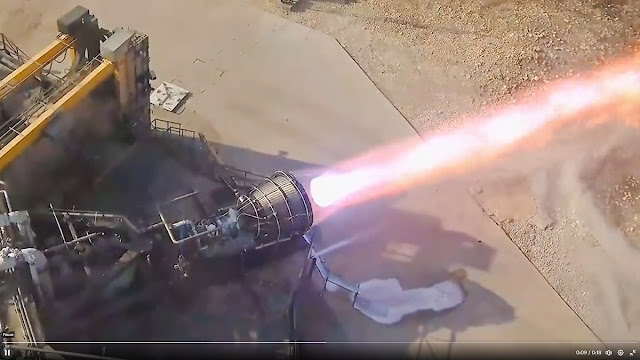SpaceX has passed a test of starting a Raptor engine after cold soaking at temperatures meant to simulate coasting unpowered for days traveling to the moon. This is considered a critical test to clear Raptors in the Human Landing System (HLS) to bring astronauts from the Artemis III mission down to the lunar surface in 2025 or '26. The test only ran the engine for three seconds, since the object of the test was to verify starting at cryogenic temperatures and those temperatures go away pretty quickly. The test was conducted in August but NASA's Artemis blog only posted about it Thursday (Sept. 14). SpaceX tweeted a short, 18 second, video on X the same day, showing the test ignition and burn.
Screen capture from the SpaceX video on X.
As for the Raptor engine test, NASA officials said its success gives the agency more confidence that SpaceX is progressing toward its Artemis 3 obligations. "These tests provide early and mission-like validation of the systems necessary for carrying astronauts to and from the lunar surface," agency officials wrote in the blog post. "Data reviews following these tests provide NASA with continually increasing confidence in U.S. industry's readiness for the mission."
This is the second major test of Raptor engine capabilities for NASA and Artemis. In November '21, SpaceX ran the engine for the duration needed for the long descent to the moon, 281 seconds (4.5 minutes). The Raptor also had its power level changed during the test to verify those mission requirements.
You might recall that this June, NASA Associate Administrator Jim Free blasted Starship along with Boeing's Starliner as being fixed price contracts that haven't lived up to his expectations. He doubted that SpaceX could meet a 2025 launch date and might force the mission out to '26.
In the Aug. 8 press conference at NASA's Kennedy Space Center in Florida attended by Space.com, Free suggested the agency could leave off the moon landing for Artemis 3,if necessary, and fly an alternate mission with a crew. In that scenario, Starship would be used on a future mission (such as Artemis 4) for the first human lunar landing since Apollo 17 in 1972.
The agency is looking for multiple successful launches by Starship ahead of authorizing the landing with astronauts, among other milestones, Free said. (Indeed, NASA wrote in its blog post on Thursday that the agency will be watching the performance of Raptor engines during the second launch attempt by Starship.)
There are a few things SpaceX must demonstrate before a lunar landing in addition to getting Starship into orbit successfully. Of these, the biggest hurdle seems to be successful orbital refueling. If every Starbase launch is delayed by some agency, the next moon landing is also delayed. Perhaps NASA might lean on the FAA, FWS, DOJ and any other government bureau trying to impede SpaceX's progress.

The way things are looking right now, SpaceX will be able to take astronauts to the moon long before the Lunar Gateway and Artemis are ready for astronauts.
ReplyDeleteSeriously, by 2025/2026 I fully expect HLS to be able to transport 15 or so astronauts to lunar orbit and then to the moon, while the launch tower for the SLS and the last part of Lunar Gateway are still being worked on.
"Perhaps NASA might lean on the FAA, FWS, DOJ and any other government bureau trying to impede SpaceX's progress."
ReplyDeleteI couldn't agree more. It is ridiculous that politics tend to come ahead of anything else in government, especially these days.
The only opinions that count with this Administration are those of the watermelons, who have NO interest in the moon!
DeleteWhat do you want to bet DoD is leaning on some of the other Agencies heavily...
DeleteJust sayin'
Somebody in a position of power does not like what SpaceX is doing.
ReplyDeleteThe people in power don't like fixed price contracts. Instead of just being late, like Starliner, they're late and cost us more like Artemis/SLS. One has to conclude that those opposed to fixed price contracts, like administrator Free, are either getting a contribution from the over budget money or are being set up for jobs in those companies when they retire. Further, I'd conclude the same for the congress critters we've seen advocating for cost-plus contracts.
DeleteThey don't like fixed price contracts because you only have one opportunity for a kickback. Cost+ contracts assure you of an endless supply of kickbacks.
DeleteRemember, the Biden Administration hates Musk.
ReplyDeleteActually, The Powers Behind The Throne hate success. Biden barely remembers his wife.
DeleteCool pic.
ReplyDelete